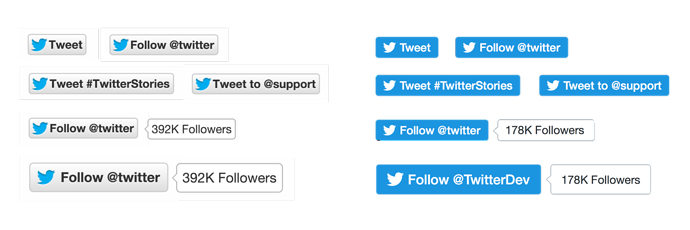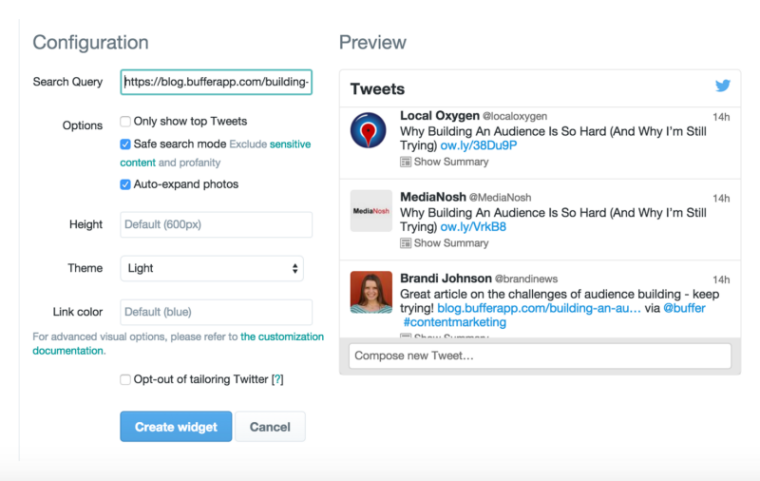Social networks are always making updates and tweaks to their platforms.
In a recent update, Twitter removed share counts from their Tweet buttons, affecting many bloggers and publishers.
As some data has started to emerge on how the has change affected content sharing on Twitter, we wanted to dive below the surface of this update and see how this change could affect marketers.
Let’s get started.
Meet Twitter’s New Share Buttons
Like other recent Twitter changes, this one appears mostly cosmetic on the surface. Share buttons still function exactly the same. They just have a new lick of paint as you can see below:

The key difference is that share counts have been removed from the new buttons, as Twitter announced in a blog post on October 6th, and from that date share counts started to disappear from the platform’s social sharing buttons.
Below you can see the updated share button on the Buffer blog:

At a first glance this may not sound like an earthshaking development. However, for many the share count data was a useful guide point on post performance and also a way to promote content with readers by showcasing the post’s popularity.
Do Share Counts Influence Twitter Sharing Activity?
We wanted to dive in and find out if removing the share count has had any effect on the number of people sharing to Twitter.
This is where the new update gets really interesting. Shareaholic pulled together and analyzed sharing activity data generated across the 300,000+ sites that use their product.
The data shows that sharing activity to Twitter has declined by 11.28% since November 20th.
The decline in sharing is in the “share of voice”, the percentage of Twitter shares, relative to other sharing destinations available such as Facebook, Pinterest, LinkedIn, etc.
Are People Still Posting to Twitter Through Buffer?
After seeing this data we decided to hop into our own Buffer data and check the number of posts being shared to Twitter through Buffer before and after November 20th and, as you can see below, there’s been no significant change:

What Does This Mean for Publishers and Site Owners?
Share buttons have been synonymous with blogs and websites since social media started to break into the mainstream and, since the beginning, the share count has usually been at the core of each button. (I remember when I first started blogging I’d often turn to the share count as my first validation of a post succeeding.)
Out of everyone, the removal of share counts from Twitter’s social buttons will likely have the most effect on publishers and bloggers.
One of the big advantages to having the Twitter share count was the social validation that other people have also enjoyed and shared the post. This is something that Slate’s vice chairman Dan Check explains more on over at Digiday:
It’s meaningful to us. Having share counts along comment counts is a strong way to underline that there’s a conversation around what we’re written. We want to signal to readers that that conversation is happening.
How to Show Social Validation Without Share Counts
Studies show that we unconsciously look to others to guide us. When we can see a post has been shared hundreds or thousands of times before, this social validation makes us more likely to share.
And, with these updated Twitter buttons, some of that social validation has gone missing.
Thankfully there are a few ways you can show social validation and conversation around a post without relying on share counts.
Embed a Tweet Sharing Your Post
This is something we’ve done at Buffer before and I could see it becoming a more common tactic now that Twitter share counts have been removed. Here’s an example:
If you are looking for new places to learn about marketing, we offer you 43 picks! https://t.co/FpIop32FCf pic.twitter.com/GyeKxIRAtW
— Buffer (@buffer) January 3, 2016
The embedded Tweet will show readers the number of Retweets and Likes the Tweet has received and go some way to replacing the social validation lost with the updated buttons.
Embed a Search
If you head over to Twitter Search and run a quick search for the URL of your post, you’ll be able to collate all the Tweets where someone has shared your post.
To embed this search within your blog post, simply click ‘More Options’ from the results page and then select ‘Embed Search’ from the dropdown menu.

You’ll then be taken to a page where you can configure and edit your search:

Once you’ve configured your search, click ‘Create widget’ and you’ll be given some code to copy and past into your blog post.
Here’s how an embedded search looks:
Experiment With Different Buttons and Locations
While Shareaholic data suggests that Twitter sharing numbers have dropped since the share counts have been removed, not everyone is finding that the case, as New York Magazine’s Digital GM, Michael Silberman, explains:
We have some evidence that the premise — share counts encourage more sharing — isn’t even true. And of course on mobile, for our site and many others, you can’t even see the share counts unless you tap to share. (And most sharing is happening in the address bar on desktop or iOS share sheet anyway.)
On their blog, Crew editor Jory MacKay shared some of their findings about share buttons after some experimentation.
Crew found that readers are more likely to share using the buttons at the bottom of a post, compared to the ones at the top. MacKay believes there are a couple of reasons for this trend:
- The share buttons are more obvious and recognizable at the bottom.
- People are more likely to share a post that they’ve read through.
In his post, MacKay also refers to the importance of prototypical elements:
In the most basic terms, this just means we like what we know. When we expect to see something on a website in a specific place with a specific style (like sharing buttons at the top or down the lefthand side of a post) we feel good when they’re there and disconnected and unsure when they aren’t.
These findings suggest that while share counts can be useful, you can also boost your sharing numbers by experimenting with different styles of buttons and layouts.
Over to You
The loss of share counts doesn’t feel like a cause to panic about the future on Twitter sharing for publishers.
Even with a potential drop in sharing, we may soon see things pan out and sharing return to normal levels. And with more reason to experiment with new layouts and ways to encourage sharing, it could even lead to new findings and increased sharing.
Have you noticed any difference in the amount of shares your posts have received since Twitter removed the share count? Have you tried any new ways to encourage sharing? Let us know in the comments.
This post originally appeared on Buffer, and is re-published with permission.
Image Credits
Featured Image: Image by Ash Read
All screenshots by Ash Read. Taken January 2016.





![AI Overviews: We Reverse-Engineered Them So You Don't Have To [+ What You Need To Do Next]](https://www.searchenginejournal.com/wp-content/uploads/2025/04/sidebar1x-455.png)